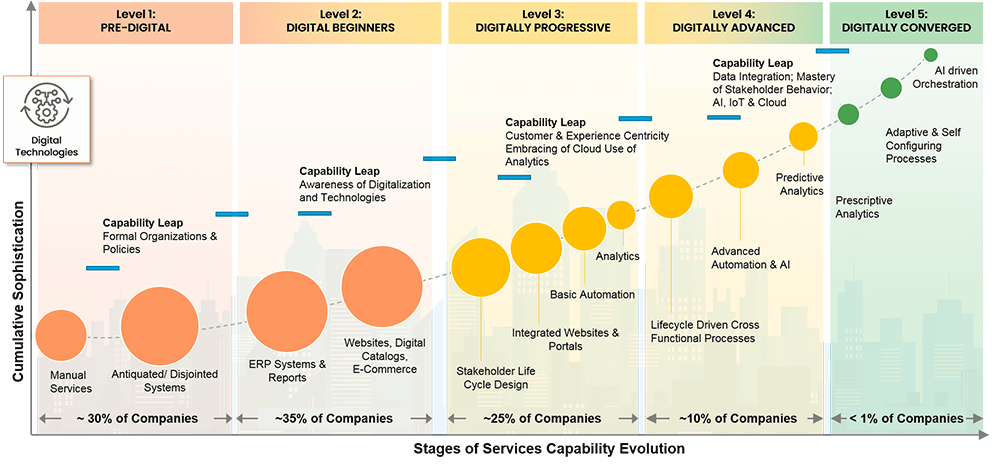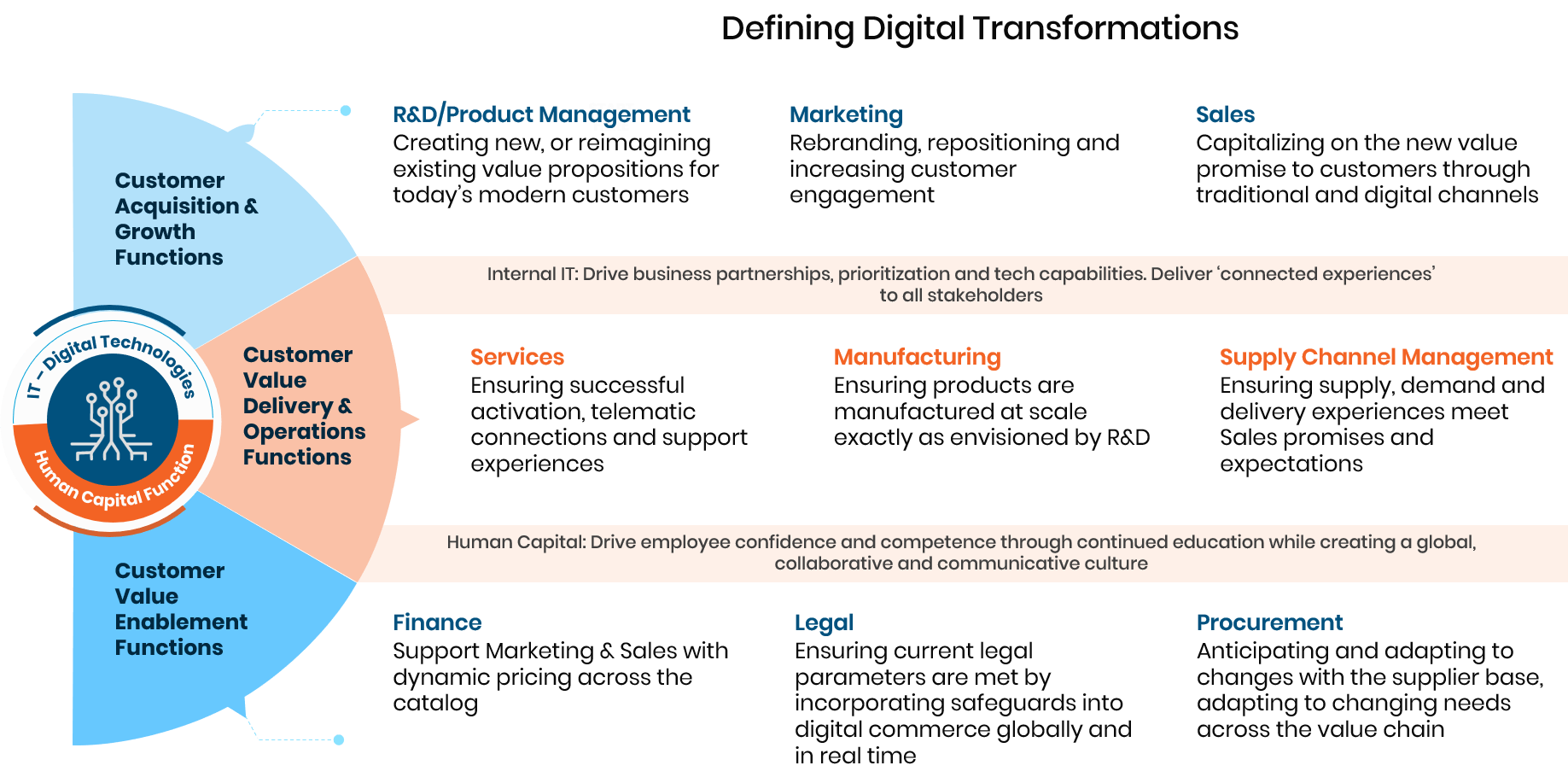Translate strategy into an action plan with a clear and agile path to execution
Businesses born before the digital age must substantially transform themselves to remain relevant in the marketplace and find new ways of engaging connected employees and customers. In fact, Trianz research shows that nearly 30% of companies will not survive this decade due to a lack of alignment with how customers define value in the digital age.
This is exactly why digital transformation is such a hot topic now, and will continue to be for years to come. Organizations are finding new ways to survive the dual onslaught of increasing global digitalization and bottom-line impacts of the pandemic. Technology and data analytics are at the heart of the solution; that’s the “digital” in the transformation.
Once they know where they need to go, the companies most likely to succeed will seek out the best digital transformation roadmap they can find.
Benchmarking: How You Stack Up and Where You’re Starting From
Every great journey must start out with knowing exactly where you are, a.k.a., benchmarking. Enter the Digital Enterprise Evolution Model™ (DEEM).
What is DEEM?
Digital transformation looks different for different organizations. To help companies understand where they are on the spectrum and the next steps in the journey, we have created DEEM.
Digital Enterprise Evolution Model™

Copyright © 2021 Trianz
This is when leadership takes a cold, hard look in the mirror to pinpoint where they are on the digital maturity curve. The No. 1 predictor of failure or success in a digital transformation – regardless of the investment – is understanding what digital transformation has in store for them in this high-stakes, highly resource-constrained environment.
Prior to Trianz’ own digital transformation, CEO Sri Manchala sought to determine our current position and the different stages of Trianz’s digital maturity over time. He explained, “All companies must do this to know how they stack up against comparable organizations in their industries, as well as examine the ‘digital IQ’ of their leaders.”
Levels of DEEM
There are five different stages that your company could be in, and it depends on where you are in the journey:
Level 1 – Pre-Digital
This is the simplest stage, where transformation means the deployment of a standalone, information-oriented website for a function or department.
Level 2 – Digital Beginners
In this stage, there has been an expansion to integrated websites and portals.
Level 3 – Digital Progressives
The focus is now on providing a hybrid stakeholder experience by digitalizing the chain of activities.
Level 4 – Digitally Advanced
The company transforms its product/service portfolios and operations, while reinventing its value chain across the enterprise.
It also makes data-based decisions from a rich analytics infrastructure – a key part of building a business model relevant to the marketplace. Sometimes this means disrupting previously successful business models to deliver a re-imagined customer value proposition that offers a holistic digital experience.
Level 5 – Converged Digital Enterprises
These companies have a sharp, well-aligned, and high digital-IQ leadership, as well as well-trained talent, digital workplaces, and modern, global cultures.
Through these stages of digital transformation, you will make capability leaps through cloud use of analytics, customer and experience centricity, basic automation, data integration, mastery of stakeholder behavior, artificial intelligence (AI), Internet of Things, advanced automation, adaptive and self-configuring processes, and AI orchestration.
Strategy for Getting From Your Current Status to Level 5
Your North Star: Customers
To compete and win, businesses need to remember what should be central to your strategy: the customer. Digital transformation can help provide your customers with better service and preserve revenue during periods of economic disruption, enabling you to remain relevant in a rapidly developing dynamic market.
Improving the customer experience and market relevance should be your short-term business goal and No. 1 digital priority.

Copyright © 2021 Trianz
Design the Roadmap
Execution in the digital context is vastly different from traditional implementations. Agility isn’t just helpful—it’s paramount. Like a game of chess, companies must plan their moves in advance and yet do so with many different scenarios in mind.
Our experts advise mapping out scenarios to cover five important bases:

Strategy is both intended and emergent, therefore we believe that one of the most important layers of digital road mapping is contingency planning. For instance, “If X happens, then what?” Contingency models can be designed that theoretically apply to near-infinite scenarios. This is what we refer to as a “living roadmap” that is multi-layered and covers every angle.
Always expect the unexpected
Though the number changes every year, the fact remains – few digital transformations succeed. We have diligently researched this issue and our data tells us why this is the case. The explanation is multi-factor and nuanced, but suffice to say, digital champions do not take uncertainty for granted.
 Digital champions – or, those most likely to succeed – know that uncertainty is a certainty. They expect it. They plan for it. And they don’t get upset or derailed when it inevitably occurs. Why? Because they have anticipated the emergence of new customer needs and new industry dynamics; it was included in their roadmap from the beginning.
Digital champions – or, those most likely to succeed – know that uncertainty is a certainty. They expect it. They plan for it. And they don’t get upset or derailed when it inevitably occurs. Why? Because they have anticipated the emergence of new customer needs and new industry dynamics; it was included in their roadmap from the beginning.
Make Sure You Have the Resources and Skills to Execute
Digital transformation is not a destination. It is a continuous and iterative state achieved via a function of these elements, the factors that can determine its success or failure:
- Leadership IQ and data-driven decision making in the digital era
- Product and service portfolio transformation
- Value chain transformation
- Organization, talent, and cultural transformation
It’s getting almost cliché to say that data is at the heart of these transformations and the lifeblood of the digitalization process. But it is an unmovable truth that companies are investing hugely now to leveraging big data to improve customer experiences, open new markets, make employees and processes more productive, and create new sources of competitive advantages to successfully work toward the future.
Along with data, people play an equally critical role—from people who are in decision-making roles to those in execution roles. When transformations become talent-driven, they almost always guarantee success. Our data shows clearly that role-based training of employees is the number-one driver of transformation success in every single industry, function, and role. Companies with high levels of success made the highest level of investment in training.
Questions to Ask
When preparing for creating your digital transformation roadmap, ask yourself the following questions:
- What is the digital IQ of your leadership team?
- Do you have the right teams to execute the plan?
- Do you have a clear vision of where you want to be?
- Do you have buy-in from key stakeholders?
- Are your competitors using existing or new technology to disrupt and expand the market?
- Are you, as a company, making data-based decisions? Are you seeing new trends in your corporate data?
- Do you know what your customers really want, and if their needs have changed, or are your decisions based on your feelings or intuition?
- Does your business model need to change with respect to your competitors?
Create a Well-Defined Roadmap for Victory
Strategy matters, as does execution—but neither count if we fail to blaze the path between. While the journey may be challenging, its payout is worth all the effort.
Trianz is a trailblazer when it comes to mapping digital success. For the last decade, we have supported numerous large enterprise clients in making the leap to digital transformation.
Our roadmap experts will do more than just guide you through the entire process of digital roadmap creation. They will also hold you accountable for it all the way to the end until every aspect of your plan has materialized, and you are seeing the outcomes that were predicted.
Beyond this timeline, our managed service teams and consultants will continue to support you as you strive to reach even greater heights. After all, digital transformation is just the beginning. Once you are leaner, faster, and data-driven, you will discover new business models within your activity that you had never considered before.